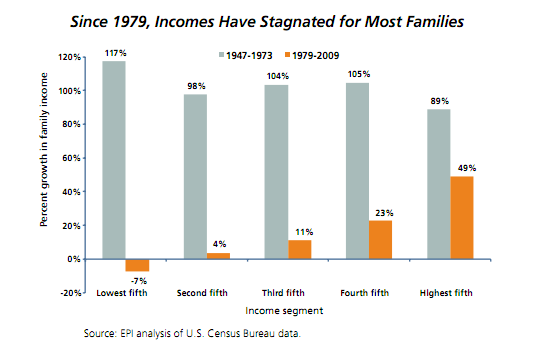
OVERVIEW
MANAGEMENT
PERFORMANCE
POSSIBILITIES
CAPITALS
ACTIVITIES
ACTORS
BURGESS
Society and Economy |
|
COMMENTARY I like the idea that David Callahan is looking to use a metric that is more than merely the profit of an investment ... but I would argue that the equity idea does not go far enough. I am working on a similar idea that is based on the idea that all economic activity has a purpose, and we need to be able to measure the valueadd from this as well as the profit. For profit there is GAAP accounting that is about 400 years old and works very well, but the valueadd element is new and not working very well up to this point. Peter Burgess |
|
It's one thing to agree that today's economy is only working for a sliver of households at the top; it is quite another to lay out a blueprint for changing that and creating truly shared prosperity. The growing gap between the Haves and everyone else is fanned by large-scale trends like globalization and technological change, and has been deepened and reinforced by a 'winner-take-all politics' that favors the wealthy.
Undoing this structural inequality won't be easy, but -- finally -- this challenge is now moving onto the national agenda and ideas for fostering equity are getting more of a hearing. In that sense, a new report by PolicyLink, released today, could not be more timely. The report, 'America's Tomorrow: Equity is the Superior Growth Model,' offers a big picture vision for not only spurring economic growth, but doing so in a way that addresses the huge racial chasms around wealth and opportunity. (The report was written by Sarah Treuhaft, Manuel Pastor, and Angela Blackwell, who is the president of PolicyLink, in collaboration with the University of Southern California’s Program for Environmental and Regional Equity) In framing the case for equity, the report recites a grim litany of evidence that America's middle class is in decline and that communities of color are especially hard hit. But the report also makes two less familiar points that deserve a more central place in the economic debate: First, the authors point to growing evidence -- both cross-nationally and in the U.S. -- that inequality undermes economic growth. (A point I have written about here before.) Any growth strategy, they rightly note, needs to tackle the equity challenge in order to succeed. A second point the authors stress is that a new growth strategy should seek to leverage America's growing diversity as a competitive advantage globally. The report underlines just how much diversity is changing the nation: People of color are already the majority in four states (California, Hawaii, New Mexico, and Texas), in the District of Columbia, in 49 metros, and in 311 counties. Another nine states (Arizona, Florida, Georgia, Louisiana, Maryland, Mississippi, Nevada, New Jersey, and New York), 40 metros, and 241 counties are at the demographic tipping point and now have 40 to 50 percent nonwhite residents. By 2040, 13 states, 102 metros, and 602 counties are projected to be majority people of color.The authors see these demographics as a major asset. Beyond the positive benefits of diversity in bringing different ways of thinking to challenges: Growing Latino, Asian, African American, and other diverse communities are in the driver’s seat of new business creation and represent a significant new consumer base.Guided by these two core premises -- that a growth strategy needs to maximize equity and leverage diversity -- the report goes on to suggest three main strategies going forward. First, a major investment in the physical infrastructure (including communications) needed to create the conditions where growth can happen; second, a focus on aiding small businesses, which are the engines of job growth, especially in low-income communities; and third, a big investment in human capital so that workers have the right skills and education to take advantage of 21st century opportunities. These are familiar ideas, of course, but it's very useful to see them in one place and linked to a big picture vision of creating a more equitable tomorrow in a future America that -- demographically -- will look drastically different from the nation we live in today.
|
|
David Callahan
November 8, 2011 |
| The text being discussed is available at http://www.policyshop.net/home/2011/11/8/equitable-growth-policylinks-economic-vision.html |
